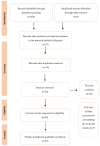Microbial Contamination of Bedding Material: One Health in Poultry Production
- PMID: 36554388
- PMCID: PMC9779247
- DOI: 10.3390/ijerph192416508
Microbial Contamination of Bedding Material: One Health in Poultry Production
Abstract
In poultry farms, the mixture of bedding material, chicken excrement, and feathers seems to play an important role in pathogen development which may contribute to a potential risk of zoonosis, spreading the disease through the food chain. The purpose of this study was to analyze microbial contamination in bedding material and other matrices as well as potential antimicrobial resistances in chicken production facilities, and also to identify the sampling techniques and assays used. This study evidences the available data published, following the PRISMA methodology. Among the environmental samples, surface swabs were frequently used as a passive sampling technique. Morphological identification was performed in all studies. From all the matrices, the bedding material was the most contaminated. Most studies focused on bacterial contamination, with Salmonella sp. and Campylobacter sp. being commonly reported and three studies evidenced fungal contamination, being Penicillium sp.- and Aspergillus sp.-dominant. Mycotoxin assessment was only performed in one study, being identified in all bedding samples. The screening for bacteria resistance evidenced bacteria multidrug resistance; however, fungal susceptibility to azoles was not assessed in any of the analyzed studies. Briefly, this review evidences the microbial contamination in poultry facilities, emphasizing animals' bedding as a potential source of contamination. Additionally, this study contributes to a sampling and analysis protocol proposal to assess the microbial contamination in this setting. Additionally, the knowledge gaps identified highlight the need of further research regarding microbial contamination and toxicological potential on animals' bedding in order to mitigate the exposure in poultry pavilions.
Keywords: microbial contamination; microbial resistance; mycotoxins; poultry bedding material.
Conflict of interest statement
The authors declare no conflict of interest.
Figures
Similar articles
-
One Health Approach to Tackle Microbial Contamination on Poultries-A Systematic Review.Toxics. 2023 Apr 14;11(4):374. doi: 10.3390/toxics11040374. Toxics. 2023. PMID: 37112601 Free PMC article. Review.
-
Fungal contamination of poultry litter: a public health problem.J Toxicol Environ Health A. 2012;75(22-23):1341-50. doi: 10.1080/15287394.2012.721165. J Toxicol Environ Health A. 2012. PMID: 23095152
-
National Outbreak of Multidrug Resistant Salmonella Heidelberg Infections Linked to a Single Poultry Company.PLoS One. 2016 Sep 15;11(9):e0162369. doi: 10.1371/journal.pone.0162369. eCollection 2016. PLoS One. 2016. PMID: 27631492 Free PMC article.
-
Sources of Salmonella contamination during broiler production in Eastern Spain.Prev Vet Med. 2011 Jan 1;98(1):39-45. doi: 10.1016/j.prevetmed.2010.09.006. Epub 2010 Oct 29. Prev Vet Med. 2011. PMID: 21035883
-
Cross-contamination versus undercooking of poultry meat or eggs - which risks need to be managed first?Int J Food Microbiol. 2009 Aug 31;134(1-2):21-8. doi: 10.1016/j.ijfoodmicro.2009.02.012. Epub 2009 Feb 23. Int J Food Microbiol. 2009. PMID: 19272666 Review.
Cited by
-
Effects of exposing Japanese quail eggs to a low dose of gamma radiation and in ovo feeding by two sources of trace elements on embryonic development activities.Poult Sci. 2024 Mar;103(3):103364. doi: 10.1016/j.psj.2023.103364. Epub 2023 Dec 9. Poult Sci. 2024. PMID: 38198914 Free PMC article.
-
One Health Approach to Tackle Microbial Contamination on Poultries-A Systematic Review.Toxics. 2023 Apr 14;11(4):374. doi: 10.3390/toxics11040374. Toxics. 2023. PMID: 37112601 Free PMC article. Review.
-
Hazards Associated with the Combined Application of Fungicides and Poultry Litter in Agricultural Areas.J Xenobiot. 2024 Jan 9;14(1):110-134. doi: 10.3390/jox14010007. J Xenobiot. 2024. PMID: 38249104 Free PMC article. Review.
-
Chopped straw and coffee husks affect bedding chemical composition and the performance and foot pad condition of broiler chickens.Sci Rep. 2023 Apr 23;13(1):6600. doi: 10.1038/s41598-023-33859-9. Sci Rep. 2023. PMID: 37088790 Free PMC article.
-
The Association between Broiler Litter Microbiota and the Supplementation of Bacillus Probiotics in a Leaky Gut Model.Animals (Basel). 2024 Jun 11;14(12):1758. doi: 10.3390/ani14121758. Animals (Basel). 2024. PMID: 38929376 Free PMC article.
References
-
- Kostadinova G., Petkov G., Denev S., Stefanova R., Penev T. Microbial pollution of manure, litter, air and soil in a poultry farm. Bulg. J. Agric. Sci. 2014;20:56–65.
-
- Pujiastuti E.S., Tarigan J.R., Sianturi E., Ginting B.B. IOP Conference Series: Earth and Environmental Science. Volume 205. IOP Publishing; Bristol, UK: 2018. The effect of chicken manure and beneficial microorganisms of EM-4 on growth and yield of kale (Brassica oleraceae acephala) grown on Andisol; p. 012020. - DOI
Publication types
MeSH terms
Grants and funding
LinkOut - more resources
Full Text Sources


